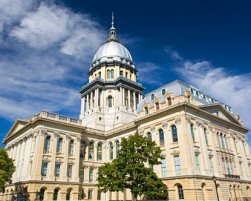Updated: May 31, 9:50am
There is a whirlwind of education funding reforms and budget bill spending in the General Assembly right now. If you’re having trouble keeping up, this blog is for you.
SB 231 (MANAR/C. MITCHELL): BETTER FUNDING FOR BETTER SCHOOLS BILL
SB 231 moves Illinois’s most-regressive-in-the-nation state school funding method from a complex web of formulas to a single, integrated formula that uses weights based on each school district’s poverty concentration, number of students learning English, special education needs, and other characteristics. Nearly every education dollar would be spent to close funding gaps between high-poverty districts and those that are better off.
The bill also includes an “Adequacy Grant” so that no district that is underfunded would lose state resources as long as its local property tax rate is near or above the statewide average rate. A “Hold Harmless” provision is also included so that every district gets at least the same amount from the state as it did last year. The Hold Harmless provision would phase out over four years. The bill would also cover “normal cost” of Chicago’s teacher pensions – currently the only school district that pays for its own current costs of teachers’ pensions is Chicago Public Schools; under SB 231 the State would pick up those costs as it does for every other school district in the state.
After three years of hard work setting the stage for a long-term funding fix, SB 231 passed the Senate on May 10, 2016. SB 231 is posted for House Executive Committee on May 31, which is the last day of regular session.
HB 3190 (LIGHTFORD/W. DAVIS): BETTER FUNDING FOR BETTER SCHOOLS PLUS AN EVIDENCE-BASED MODEL
The “evidence-based” approach to school funding considers what practices lead to improved student learning and how much it costs to fund those practices. That includes class sizes of 15 in grades K-3, class sizes of 25 in grades 4-12, 1:1 technology, and appropriate ratios of students to counselors, interventionists, art and music teachers, and other school personnel. Schools would not be required to spend their funds on those programs but, according to the evidence-based model, when they are fully funded, they would have the adequate resources that research shows would provide a high-quality education.
HB 3190 would incorporate the weights from SB 231 in FY17 to provide immediate relief for the neediest districts, while holding harmless other districts. The formula would transition to evidence-based weights in FY18 and thereafter.
As for distributing state resources, HB 3190 would divide districts into multiple “tiers” that reflect how close they are to being adequately funded. Districts that are furthest from adequacy are in Tier One and would be prioritized first. Almost all funding would go to Tiers One and Two, but even the richest districts would get 1% of the total appropriation so every district would see some small increase over the years.
HB 3190 passed the Senate on May 27, 2016. The House would need to concur with the Senate’s changes for it to be sent to the Governor, though no motion to concur has been filed as of this writing.
SB 2048 (CURRIE/J. CULLERTON): EQUITY GRANT IN FY17 BUDGET BILL
The House created an Education Funding Reform Task Force that has been meeting for almost two years. The Task Force Chair sponsored SB 2048, saying that the committee found inequities in the current formula and that this one-year infusion of funding through the poverty grant would raise the floor for poorer districts while the committee continues its work. SB 2048 also includes appropriations for other areas of the budget.
The bill appropriates $700 million through the poverty grant formula, with every district receiving some increased appropriation. Districts would receive the same amount of General State Aid (GSA) they received in FY16, and those that would have seen an increase if GSA were fully funded in FY17 would also receive that additional amount.
An additional $100 million is appropriated for the Chicago Teachers’ Pension Fund.
SB 2048 passed the House last week. The Senate would need to concur with the House’s amendment in order for it to be sent to the Governor, though no motion to concur has been filed as of this writing.
HB 813 (J. CULLERTON/GABEL): MODIFIED EQUITY GRANT
Mirroring the SB 2048 framework, HB 813 incorporates the GSA Hold Harmless and retains all of the categorical programs formulas. However, instead of using the existing poverty grant formula, it creates an Equity Grant formula that would drive new dollars to the districts that most need them. Though it does not make structural changes to the way current dollars in the system are spent, new funds would be allocated in a significantly more equitable way. The Equity Grant is similar to the existing poverty grant with two differences: (1) It adds a measure of local wealth to the calculation to “equalize” the grant; and (2) it raises the amount of the grant for middle-poverty districts (those with about 50% low-income students), who are shortchanged in the current poverty grant.
The bill also creates a continuing appropriation for the Chicago Teachers’ Pension Fund (CTPF) “normal cost” going forward. It requires the Chicago City Council to approve a dedicated tax levy of 0.26% to fund CTPF. (Before 1995, CPS had a dedicated pension levy of 0.26% to pay teacher pension costs.)
HB 813 passed the House on May 27, 2016. The House would need to concur with the Senate’s changes for the bill to be sent to the Governor, though no motion to concur has been filed as of this writing.
P.S.: I only wrote about the four education funding bills that moved in the last couple of weeks, but requests are coming in for a fuller list:
GOVERNOR’S INTRO BUDGET
The Governor introduced budget proposed full funding of the current Foundation Level, which would increase the General State Aid appropriation by $51 million. (It also included an additional $75 million for early childhood among the many other programs that make up ISBE’s $7+ billion General Funds budget.)
SB 3434 (Barickman): SENATE REPUBLICAN BUDGET BILL
The newly-filed Senate Republican budget bill would fully fund General State Aid and create a Hold Harmless provision so that no district loses more than it received last year, which adds $105 million to the education budget.
HB 828 (W. Davis): THE EVIDENCE-BASED MODEL
HB 828 represents a fundamental change in the way IL funds schools. The bill defines adequate spending for each district depending on its student characteristics, holds districts harmless so no one “loses,” and changes the distribution of state resources to better direct dollars to needier districts. It is similar to HB 3190 (Lightford/W. Davis), except that it does not incorporate SB 231 weights for the first year.
HB 829 (Currie)
House Amendment 1 includes the language from SB 231. It was filed because the bill is in position to be called for a floor vote in the House.





